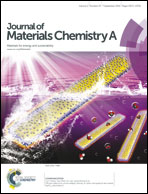Gas uptake, molecular sensing and organocatalytic performances of a multifunctional carbazole-based conjugated microporous polymer†
Abstract
A multifunctional carbazole-based conjugated microporous polymer MFCMP-1 is successfully prepared by oxidative coupling polymerization using a single monomer and structurally characterized. A new three-dimensional π-conjugated polymer framework can be combined with permanent microporous, highly luminescent properties and abundant nitrogen activated sites in the skeleton. It possesses a large BET surface area of over 840 m2 g−1 with a pore volume of 0.52 cm3 g−1, and displays a high carbon dioxide uptake capacity (up to 3.69 mmol g−1) at 273 K and 1 bar, with good selectivity towards CO2 over N2 and CH4. MFCMP-1 exhibits also strong fluorescent emission at 529 nm after excitation at 380 nm in THF solution and works as a luminescent chemosensor towards hazardous and explosive molecules, such as nitrobenzene, 2-nitrotoluene, and 2,4-dinitrotoluene. In addition, MFCMP-1 features a high concentration of Lewis base nitrogen sites on its internal surfaces; it thus acts as a highly efficient recyclable heterogeneous organocatalyst towards Knoevenagel reaction of malononitrile with aromatics, heterocyclic aldehydes, and cyclic ketones. Furthermore, we further highlight that the ease of synthesis and low cost, coupled with multifunctional properties, make MFCMP-1 an attractive functional material in practical applications.


 Please wait while we load your content...
Please wait while we load your content...